2. 大连理工大学环境学院, 大连 116024
2. School of Environmental Science and Technology, Dalian University of Technology, Dalian 116024, China
杀菌剂、杀虫剂和除草剂等化学农药作为重要的农业生产资料, 可有效防治病虫杂草危害, 确保农作物产量[1].随着化学农药的大规模应用, 环境中化学农药的残留问题备受社会关注[2, 3].化学农药造成的农业非点源污染已对饮用水资源和水生生态系统造成威胁[4~6].化学农药可通过地表径流、农田退水和污水处理厂排放等方式汇入海洋[7].尽管有研究表明化学农药残留浓度由河流向海洋呈递减趋势[8], 但海洋环境中的痕量化学农药残留仍被证实存在潜在生态风险[9].
我国是全球最大的农药生产国和消费国之一[10].据统计, 我国农药年均使用量约为40万t, 其中三大类农药(杀菌剂、杀虫剂和除草剂)在我国农药使用量中的比例高达95%[11].农药大量使用导致我国受纳水体中广泛存在化学农药的残留[12].近年来, 我国陆续开展水环境中在用化学农药(current use pesticides, CUPs)残留浓度水平调查研究.例如, 九龙江流域表层水体中共有82种农药被检出, 其中低毒性杀菌剂腐霉利浓度高达3 904 ng ·L-1[13]. Tang等[14]在对广州农村河流表层水体调查研究中共检测出11种CUPs, 其中有5种农药最高浓度超过100 ng ·L-1.近岸海域表层海水中CUPs残留浓度水平的调查则主要集中于莱州湾[15]和海州湾[8], 其表层海水中均证实存在除草剂残留.
近年来, 辽宁省持续加强水环境监管力度, 有力推动了水环境功能区水质改善, 但仍有研究报道称辽宁所辖地表水水域及近岸海域表层水体中存在多种痕量污染物残留[16~19], 其环境风险压力依然存在.Dong等[20]在对大连市饮用水源地化学农药残留量调查中发现, 碧流河水库表层水体中检出除草剂阿特拉津和乙草胺, 最高浓度分别达323 ng ·L-1和61.9 ng ·L-1.Xie等[9]对辽东半岛近岸海域表层海水中抗生素和化学农药浓度水平开展调查, 结果表明表层海水中存在杀菌剂、杀虫剂和除草剂残留.作为辽宁典型贝类增养殖区, 辽东湾西部海域和黄海东北部海域表层海水中CUPs的浓度水平及分布特征有待研究.因此, 本研究采用超高效液相色谱-串联质谱仪分析上述海域表层海水中14种CUPs的浓度水平, 利用主成分分析探讨检出CUPs残留的可能来源, 并通过风险商法评估其潜在生态风险, 以期为CUPs对辽宁所辖近岸海域生态效应的进一步研究提供科学数据.
1 材料与方法 1.1 化学品与试剂14种化学农药标准品均购于山东滨农科技有限公司, 包括3种杀菌剂:噻菌灵、甲霜灵和三唑醇; 4种杀虫剂:异丙威、吡虫清、噻虫嗪和吡虫啉; 7种除草剂:西玛津、阿特拉津、除草定、乙草胺、异丙甲草胺、甲磺隆和磺酰磺隆; 替代物阿特拉津-d5和内标甲氧苄啶-d3购于天津阿尔塔科技有限公司; 乙腈和甲醇为HPLC级(美国Sigma-Aldrich); 甲酸为LC/MS级(美国Fisher ScientificLtd.); 盐酸为优级纯(天津科密欧试剂有限公司); 乙二胺四乙酸二钠盐(Na2EDTA)为分析纯(天津凯美尔化学试剂有限公司); 实验过程用水为超纯水(Milli-Q water, 18 MΩ ·cm, 25℃).
1.2 样品采集于2019年8月在辽东湾西部和黄海东北部海域共采集33个站位表层海水样品, 采样站位如图 1所示.采样方法依照《海洋监测技术规程》(HY/T 147.1-2013)中有机污染物样品采集方式进行采集, 每个站位采集1.5 L表层海水样品, 采集深度为水面以下0.5 m处, 置于棕色玻璃样品瓶中.样品采集后4℃冷藏保存, 样品送至实验室后立刻进行样品前处理.
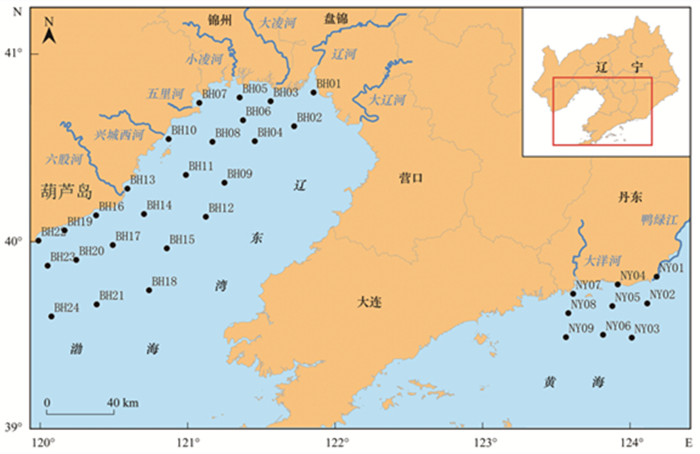
|
图 1 采样站位分布示意 Fig. 1 Location of sampling sites |
海水样品首先经0.45 μm玻璃纤维滤膜过滤.取1 L过滤后海水加入盐酸将样品pH值调节至3.0, 加入200 mg Na2EDTA以消除配合作用对目标物分析的影响, 并加入30 ng阿特拉津-d5作为回收率替代物.水样使用全自动固相萃取仪(Auto Trace 280, Thermo fisher)以5 mL ·min-1的速率过活化后的HLB萃取小柱(10 mL甲醇和15 mL超纯水活化)进行富集, 然后用10 mL超纯水淋洗, 5 mL甲醇分2次洗脱, 用氮气将洗脱液吹至300 μL.加入30 ng甲氧苄啶-d3和700 μL超纯水, 过0.2 μm的PTFE-Q滤膜, 涡旋混匀后待测.
1.4 仪器分析使用C18色谱柱(Waters Acquity, 50 mm×2.1 mm, 1.7 μm)分离目标化合物, 流动相为0.1%甲酸水溶液(A)和乙腈(B), 流动相梯度为:0~1.0 min, 95%A; 1.0~5.5 min, 95% ~15%A; 5.5~6.0 min, 15%A; 6.0~6.1 min, 15% ~95%A; 6.1~9.5 min, 95%A.流速为0.3 mL ·min-1, 进样量为5 μL, 柱温保持在40℃.运用超高效液相色谱串联三重四级杆质谱(Waters Xevo TQ-S), ESI正离子扫描模式及多反应离子监测模式(MRM)对目标化合物进行分析, 质谱检测参数见表 1.
|
|
表 1 14种目标化合物的MS/MS检测参数1) Table 1 MS/MS parameters of 14 target compounds |
1.5 质量控制与保证(QA/QC)
为避免污染, 采样前采样工具和棕色样品瓶均使用超纯水和甲醇进行清洗并干燥.本实验过程中使用程序空白检查样品采集、储存、运输和提取过程中的污染, 并通过加入甲氧苄啶-d3作为内标进行目标化合物定量.利用人工海水进行加标回收实验, 加标水平为20 ng ·L-1(低浓度)和200 ng ·L-1(高浓度), 每个浓度设3个平行.14种CUPs的方法定量限、回收率及相对标准偏差如表 2所示.
|
|
表 2 目标化合物方法定量限和回收率 Table 2 Limits of quantification and recoveries of target compounds |
1.6 风险评估方法
运用风险商法(risk quotient, RQ)评估在用化学农药的潜在生态风险.根据欧盟风险评价技术指导手册[21], 海水中单一污染物的风险商RQ可采用公式(1)进行计算:

|
(1) |
式中, MEC(measured environmental concentration)为污染物在环境中的检测浓度(μg ·L-1); PNEC(predicted no effect concentration)为预测无效应浓度(μg ·L-1).当RQ<0.01时, 认为污染物不存在风险; 当0.01≤RQ<0.1时, 认为污染物存在低风险; 当0.1≤RQ<1时, 认为污染物存在中等风险; 当RQ≥1时, 则认为污染物存在高风险.PNEC可通过公式(2)计算[22]:

|
(2) |
式中, LC50(lethal concentration 50)为半数致死浓度(μg ·L-1); EC50(effective concentration 50)为半数有效浓度(μg ·L-1); AF为风险评估因子, 当可查阅到3个不同营养级中至少一个LC50/EC50计算PNEC时, AF取值为1 000[23].
1.7 数据处理采用Excel 2007进行数据处理, SPSS 21.0进行统计学分析, Origin 2019、Arcgis 10.0和Surfer 11进行绘图.
2 结果与讨论 2.1 表层海水中CUPs浓度水平辽东湾西部海域和黄海东北部海域33个站位表层海水样品中共检出7种目标化合物, 包括:甲霜灵、三唑醇、吡虫清、西玛津、阿特拉津、乙草胺和异丙甲草胺.其余7种化学农药检测结果均低于定量限, 分析其原因可能是由于使用量较低或在海水中易降解.7种检出CUPs在不同站位表层海水中的浓度如图 2所示.辽宁典型海域表层海水中检出CUPs浓度范围及检出率见表 3.
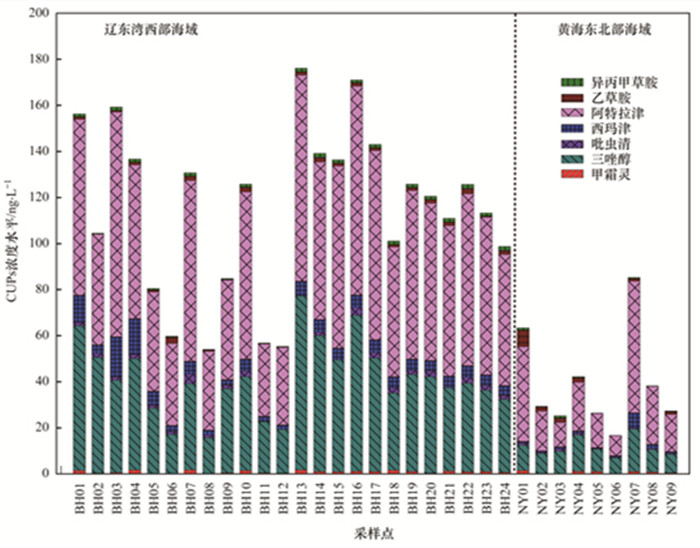
|
图 2 不同站位表层海水中在用化学农药浓度水平 Fig. 2 Concentrations of CUPs detected in surface seawaters of different sampling sites |
|
|
表 3 研究海域表层海水中在用化学农药浓度水平1) Table 3 Concentration levels of CUPs in the surface seawater of the research area |
辽东湾西部海域和黄海东北部海域表层海水检测出2种杀菌剂甲霜灵和三唑醇, 其中90.3%采样站位表层海水中检测出甲霜灵, 但检出浓度较低(辽东湾西部海域和黄海东北部海域检出浓度均值分别为0.9 ng ·L-1和0.7 ng ·L-1).三唑醇在研究海域检出率高达100%, 浓度范围分别为15.7~75.4 ng ·L-1(辽东湾西部海域)和7.0~18.5 ng ·L-1(黄海东北部海域), 占农药总检出浓度的35.3%和27.8%.三唑醇作为一种高效广谱杀菌剂, 通过影响真菌麦角甾醇的生物合成, 控制作物上的真菌和防治白粉病等病害, 可在环境中持续存在超过240 d[24], 但目前海水环境中三唑醇的残留问题未受到广泛关注.吡虫清作为氯化烟酰亚胺类杀虫剂的代表, 在美国溪流[25]、加拿大草原湿地[26]及澳大利亚河流[27]等水体中均被检出, 其在研究海域的检出浓度较低(辽东湾西部海域<LOQ~4.2 ng ·L-1, 黄海东北部海域<LOQ~1.0 ng ·L-1).阿特拉津和西玛津是全球使用量较大的除草剂, 由于痕量残留即可影响水生生物的生长繁殖, 从而通过食物链影响人类健康[28], 美国和欧盟将它们认定为内分泌干扰物, 实行限制或禁止使用[29].然而, 由于阿特拉津和西玛津在环境中持久存在, 目前仍然可在美国和欧盟的水环境样本中被检出[30, 31].我国长江三角洲区域表层水体中也检测出阿特拉津, 浓度高达1 726 ng ·L-1[32].本研究中, 阿特拉津在7种检出在用农药中浓度最高(辽东湾西部海域31.5~97.6 ng ·L-1, 黄海东北部海域8.8~57.2 ng ·L-1), 分别占农药总检出浓度的60.0%和55.5%, 辽东湾西部海域阿特拉津浓度与莱州湾海域海水样品中阿特拉津的调查结果(6.82~83.0 ng ·L-1)[15]相近, 而黄海东北部海域阿特拉津浓度与海州湾调查结果(3.9~61.9 ng ·L-1)[8]相近.西玛津浓度(辽东湾西部海域1.9~17.4 ng ·L-1, 黄海东北部海域0.6~6.6 ng ·L-1)则均高于莱州湾和海州湾海水样品中西玛津的调查结果[8, 15].此外, 乙草胺和异丙甲草胺虽然检出浓度较低, 但在辽东湾西部海域检出率均为100%.本研究结果与Xie等[9]对辽东半岛近岸海域表层海水调查结果相比, 三唑醇、阿特拉津和西玛津这3种CUPs均呈现出辽东湾西部海域浓度均值高于辽东半岛近岸海域2~4倍, 黄海东北部海域与辽东半岛近岸海域的浓度均值相近的特征, 而两项调查中乙草胺和异丙甲草胺的浓度中位值均低于1.7 ng ·L-1.
2.2 表层海水中CUPs分布特征辽东湾西部海域检出CUPs浓度(54.1~176.1 ng ·L-1)普遍高于黄海东北部海域(16.7~85.3 ng ·L-1), 这可能与污染物陆源输入、大洋环流和水体交换能力等方面因素有关.根据文献[33], 辽东湾西部海域毗邻城市葫芦岛、锦州和盘锦的农作物播种面积及耕地灌溉面积均高于黄海东北部采样站位毗邻城市丹东.由于杀菌剂、杀虫剂和除草剂等农药在作物种植中的使用日益增加[34], 由此推断辽东湾西部农药陆源排放量可能高于黄海东北部.此外, 受黄海暖流(Yellow Sea warm current, YSWC)影响, 辽宁所辖黄渤海海域呈现出复杂的水文特征[35].YSWC进入黄海北部后, 方向转西, 经辽东半岛南端老铁山进入渤海湾, 在渤海湾分流为南北两支, 北支沿辽东湾西海岸北上, 深入辽东湾内[36].由于渤海湾对YSWC的分流作用, 使得辽东湾海域水体交换能力明显减弱, 从而使得辽东湾西部海域海水稀释化学农药残留的能力弱于黄海东北部开放海域.
入海河流对辽宁典型海域近岸表层海水中CUPs的贡献度较大, 体现在CUPs总检出浓度高值区主要分布在河流入海口附近站位(图 3).辽东湾河流入海口区域表层海水采样站位中CUPs检出浓度最高的站位是BH13(176.1 ng ·L-1), 毗邻六股河口, 然后依次为大凌河口BH03(159.3 ng ·L-1)>辽河口BH01(156.2 ng ·L-1)>五里河口BH07(130.7 ng ·L-1)>兴城西河口BH10(125.8 ng ·L-1)>小凌河口BH05(80.5 ng ·L-1).近几年来小凌河断流, 减少了陆源对毗邻海域的污染输入, 可能是小凌河口较辽东湾其他河流入海口区域CUPs污染程度低的原因之一.黄海东北部海域鸭绿江口NY01农药检出浓度(63.4 ng ·L-1)与大洋河口NY07农药检出浓度(85.3 ng ·L-1)相差不大, 但超过了辽东湾湾内部分站位农药检出浓度, 因此也应该予以关注.此外, 不同采样站位检出CUPs总浓度呈现向海递减的趋势(图 3), 尤其是辽东湾西部BH16~BH18、BH19~BH21和BH22~BH24取样断带以及黄海东北部的3个取样断带均呈现出较大的浓度梯度差(图 2).这可能是因为化学农药排放入海后, 大洋环流和分子扩散可输送和稀释农药污染物, 海洋中悬浮颗粒物或沉积物同时对污染物具有吸附效应.此外, 化学农药的水解、光解或生物降解等也会进一步降低污染物的含量.
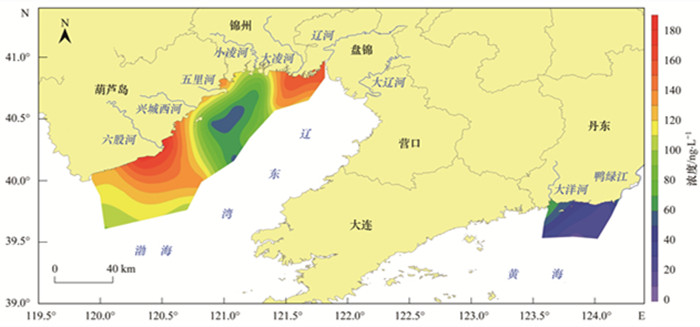
|
图 3 研究海域表层海水中在用化学农药浓度的水平分布 Fig. 3 Horizontal distribution of CUPs concentrations in the surface seawater of the research area |
为了界定研究海域内化学农药残留的主要来源, 以7种检出CUPs浓度作为变量, 利用SPSS 21.0主成分分析(PCA)进行主成分提取, 经varimax旋转后, 共提取2个主成分(PC), 分别占总方差的54.93%(PC1)和17.44%(PC2), 结果如图 4所示.由图 4(a)载荷图可知, PC1包括甲霜灵、三唑醇、吡虫清、西玛津、阿特拉津和异丙甲草胺, PC2为乙草胺.PC1各组分均为农田中广泛使用的杀菌剂、杀虫剂和除草剂.Wang等[7]的研究表明, 未被利用的农药可随农田退水经地表径流输入至水环境中, 而在处理化学农药生产厂废水的污水处理厂排水中也检测到相关农药残留[37].因此, 推断PC1各组分可能主要来源于农田退水经地表径流输入和化学农药生产厂废水未完全处理后排放等陆源污染.如图 4(b)站位贡献度得分所示, 辽东湾西部海域陆源排放污染贡献度普遍高于黄海东北部海域.乙草胺作为PC2组分, 其主要贡献度来自于黄海东北部海域, 其中鸭绿江口NY01站位对PC2的贡献度最高.乙草胺作为一种选择性芽前除草剂, 常在水果种植前或出苗前进行表土喷雾, 有文献报道称水果中可检测出较高浓度乙草胺[38].由于黄海东北部海域采样站位毗邻丹东市, 丹东市盛产草莓和杏梅等水果, 由此推断, 水果种植业可能是PC2的重要来源.
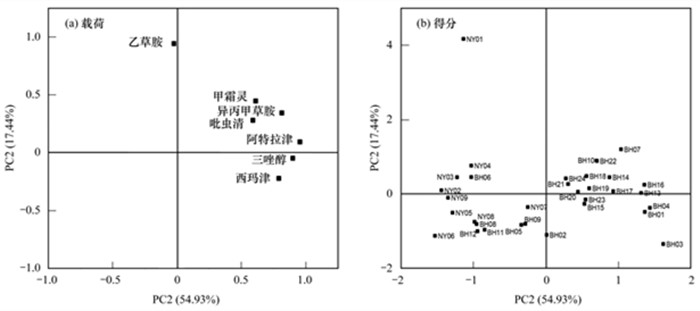
|
图 4 在用化学农药主成分分析载荷与得分 Fig. 4 Loading plot and score plot of the principal component analysis for the CUPs |
选取微藻、无脊椎动物和鱼类这3个不同营养级作为7种检出CUPs的风险评估对象, 查阅美国生态毒理数据库(ECOTOX)所对应敏感物种的LC50或EC50值如表 4所示, 其中由于缺乏甲霜灵和三唑醇对营养级海洋物种的LC50或EC50相关数据, 采用淡水物种的毒性数据代替进行潜在生态风险评估.辽宁典型海域7种CUPs对不同营养级敏感物种的潜在生态风险分析结果如图 5所示.
|
|
表 4 7种在用化学农药对微藻、无脊椎动物和鱼类的毒理数据 Table 4 Toxicity data for seven types of CUPs on algae, invertebrates, and fish |
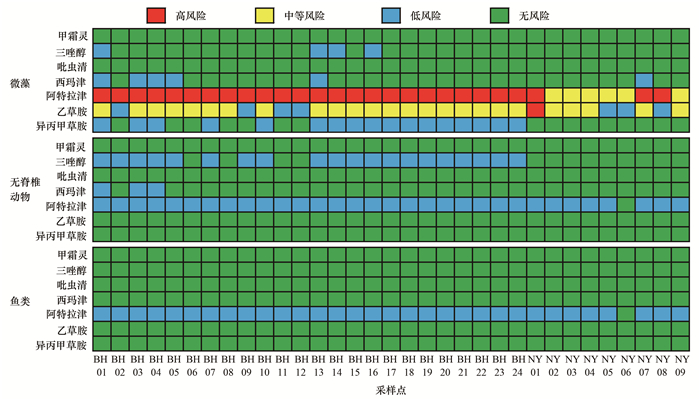
|
图 5 7种在用化学农药风险商值 Fig. 5 Risk quotients (RQs) of seven types of CUPs |
由图 5可见, 除草剂残留对辽宁典型海域的潜在生态风险高于杀菌剂和杀虫剂.阿特拉津对辽东湾西部海域微藻风险处于高风险水平, 对黄海东北部海域微藻风险处于中等-高风险水平(高风险比例为33.3%), 其对研究海域97.0%站位的无脊椎动物和鱼类也存在低风险, 与Xie等[9]的研究结果一致.尽管乙草胺在研究海域检出浓度较低, 其对微藻敏感物种中骨肋条藻(Skeletonema costatum)这一辽东湾优势种[39]的风险却值得关注(高风险比例3.0%, 中等风险比例75.8%, 低风险比例21.2%).除草剂西玛津、异丙甲草胺和杀菌剂三唑醇对辽东湾西部海域微藻存在低风险(比例分别为20.8%、70.8%和16.7%), 与此同时, 西玛津和三唑醇对无脊椎动物也存在低风险.杀菌剂甲霜灵和杀虫剂吡虫清对微藻、无脊椎动物和鱼类的RQ值均低于0.01, 说明这两种污染物可能不会对水生生物造成不良影响.尽管痕量除草剂残留对无脊椎动物存在较低风险, 但由于其对微藻具有中等-高生态风险, 可对藻类群落结构造成影响, 间接影响滤食性贝类能量供给, 从而对研究海域贝类增养殖造成潜在的生态风险, 因此应予以重点关注.此外, 由于缺乏多种化学农药同时作用的毒性数据, 并未对7种检出CUPs混合毒性进行计算, 未来应关注痕量污染物协同作用于不同营养级敏感生物所产生的风险.
3 结论(1) 辽宁典型海域表层海水中共检出7种CUPs, 总浓度范围为16.7~176.1 ng ·L-1.其中含量最高为阿特拉津和三唑醇, 在研究海域检出率为100%, 浓度范围分别为8.8~97.6 ng ·L-1和7.0~75.4 ng ·L-1, 占7种CUPs总检出浓度的56.0%和34.5%.
(2) 辽东湾西部海域检出农药浓度普遍高于黄海东北部海域.河流入海口区域浓度较高, CUPs残留量呈向海递减的趋势.
(3) 主成分分析筛选出2个总贡献度为72.37%的主成分, 第一组分含6种CUPs, 主要来源于农田退水经地表径流输入和化学农药生产厂废水未完全处理后排放等陆源污染; 第二组分乙草胺可能主要来源于水果种植业施用.
(4) 除草剂阿特拉津和乙草胺对辽宁典型海域微藻敏感物种存在中等-高风险.7种检出CUPs对研究海域内无脊椎动物和鱼类的风险则处于较低水平.
| [1] | Wang S R, Salamova A, Hites R A, et al. Spatial and seasonal distributions of current use pesticides (CUPs) in the atmospheric particulate phase in the Great Lakes region[J]. Environmental Science & Technology, 2018, 52(11): 6177-6186. |
| [2] | Stehle S, Schulz R. Agricultural insecticides threaten surface waters at the global scale[J]. Proceedings of the National Academy of Sciences of the United States of America, 2015, 112(18): 5750-5755. DOI:10.1073/pnas.1500232112 |
| [3] |
欧阳威, 鞠欣妍, 高翔, 等. 考虑面源污染的农业开发流域生态安全评价研究[J]. 中国环境科学, 2018, 38(3): 1194-1200. Ouyang W, Ju X Y, Gao X, et al. Ecological security assessment of agricultural development watershed considering non-point source pollution[J]. China Environmental Science, 2018, 38(3): 1194-1200. DOI:10.3969/j.issn.1000-6923.2018.03.048 |
| [4] | Derbalah A, Chidya R, Jadoon W, et al. Temporal trends in organophosphorus pesticides use and concentrations in river water in Japan, and risk assessment[J]. Journal of Environmental Science, 2019, 79: 135-152. DOI:10.1016/j.jes.2018.11.019 |
| [5] | Kouzayha A, Al Ashi A, Al Akoum R, et al. Occurrence of pesticide residues in Lebanon's water resources[J]. Bulletin of Environmental Contamination and Toxicology, 2013, 91(5): 503-509. DOI:10.1007/s00128-013-1071-y |
| [6] | Sun C, Chen L, Zhai L M, et al. National assessment of spatiotemporal loss in agricultural pesticides and related potential exposure risks to water quality in China[J]. Science of the Total Environment, 2019, 677: 98-107. DOI:10.1016/j.scitotenv.2019.04.346 |
| [7] | Wang R Y, Luo Y Z, Chen H J, et al. Environmental fate and impact assessment of thiobencarb application in California rice fields using RICEWQ[J]. Science of the Total Environment, 2019, 664: 669-682. DOI:10.1016/j.scitotenv.2019.02.003 |
| [8] |
张望, 范广宇, 孟祥龙, 等. 海州湾沿岸海水中21种除草剂的分布特征[J]. 江苏农业科学, 2019, 47(23): 289-294. Zhang W, Fan G Y, Meng X L, et al. Distribution characteristics of 21 herbicides in seawater along coast of Haizhou Bay[J]. Jiangsu Agricultural Sciences, 2019, 47(23): 289-294. |
| [9] | Xie H J, Wang X P, Chen J W, et al. Occurrence, distribution and ecological risks of antibiotics and pesticides in coastal waters around Liaodong Peninsula, China[J]. Science of the Total Environment, 2019, 656: 946-951. DOI:10.1016/j.scitotenv.2018.11.449 |
| [10] | Zhang C, Hu R F, Shi G M, et al. Overuse or underuse? An observation of pesticide use in China[J]. The Science of the Total Environment, 2015, 538: 1-6. DOI:10.1016/j.scitotenv.2015.08.031 |
| [11] | Ouyang W, Cai G Q, Tysklind M, et al. Temporal-spatial patterns of three types of pesticide loadings in a middle-high latitude agricultural watershed[J]. Water Research, 2017, 122: 377-386. DOI:10.1016/j.watres.2017.06.023 |
| [12] | Jiao C, Chen L, Sun C, et al. Evaluating national ecological risk of agricultural pesticides from 2004 to 2017 in China[J]. Environmental Pollution, 2020, 259. DOI:10.1016/j.envpol.2019.113778 |
| [13] | Zheng S L, Chen B, Qiu X Y, et al. Distribution and risk assessment of 82 pesticides in Jiulong river and estuary in South China[J]. Chemosphere, 2016, 144: 1177-1192. DOI:10.1016/j.chemosphere.2015.09.050 |
| [14] | Tang X Y, Yang Y, Tam N F Y, et al. Pesticides in three rural rivers in Guangzhou, China: spatiotemporal distribution and ecological risk[J]. Environmental Science and Pollution Research, 2019, 26(4): 3569-3577. DOI:10.1007/s11356-018-3808-y |
| [15] |
徐英江, 刘慧慧, 任传博, 等. 莱州湾海域表层海水中三嗪类除草剂的分布特征[J]. 渔业科学进展, 2014, 35(3): 34-39. Xu Y J, Liu H H, Ren C B, et al. Distributions of the triazine herbicides in the surface seawater of Laizhou Bay[J]. Progress in Fishery Sciences, 2014, 35(3): 34-39. |
| [16] |
张晓娇, 柏杨巍, 张远, 等. 辽河流域地表水中典型抗生素污染特征及生态风险评估[J]. 环境科学, 2017, 38(11): 4553-4561. Zhang X J, Bai Y W, Zhang Y, et al. Occurrence, distribution, and ecological risk of antibiotics in surface water in the Liaohe river basin, China[J]. Environment Science, 2017, 38(11): 4553-4561. |
| [17] | Zhang Z M, Zhang H H, Zou Y W, et al. Distribution and ecotoxicological state of phthalate esters in the sea-surface microlayer, seawater and sediment of the Bohai Sea and the Yellow Sea[J]. Environmental Pollution, 2018, 240: 235-247. DOI:10.1016/j.envpol.2018.04.056 |
| [18] | Du J, Zhao H X, Wang Y, et al. Presence and environmental risk assessment of selected antibiotics in coastal water adjacent to mariculture areas in the Bohai Sea[J]. Ecotoxicology and Environmental Safety, 2019, 177: 117-123. DOI:10.1016/j.ecoenv.2019.03.075 |
| [19] | Zhang A G, Zhao S L, Wang L L, et al. Polycyclic aromatic hydrocarbons (PAHs) in seawater and sediments from the northern Liaodong Bay, China[J]. Marine Pollution Bulletin, 2016, 113(1-2): 592-599. DOI:10.1016/j.marpolbul.2016.09.005 |
| [20] | Dong W W, Zhang Y, Quan X. Health risk assessment of heavy metals and pesticides: a case study in the main drinking water source in Dalian, China[J]. Chemosphere, 2020, 242. DOI:10.1016/j.chemosphere.2019.125113 |
| [21] | European Commission. Technical guidance document on risk assessment in support of Commission Directive 93/67/EEC on risk assessment for new notified substances[A]. In: Commission Regulation (EC) No 1488/94 and Directive 98/8/EC, Part Ⅱ[M]. Luxembourg: Office for Official Publications of the European Communities, 1996. |
| [22] | Li W H, Shi Y L, Gao L H, et al. Occurrence of antibiotics in water, sediments, aquatic plants, and animals from Baiyangdian lake in North China[J]. Chemosphere, 2012, 89(11): 1307-1315. DOI:10.1016/j.chemosphere.2012.05.079 |
| [23] | Palma P, Köck-Schulmeyer M, Alvarenga P, et al. Risk assessment of pesticides detected in surface water of the Alqueva reservoir (Guadiana basin, southern of Portugal)[J]. Science of the Total Environment, 2014, 488-489: 208-219. DOI:10.1016/j.scitotenv.2014.04.088 |
| [24] | Bromilow R H, Evans A A, Nicholls P H. Factors affecting degradation rates of five triazole fungicides in two soil types: 1. Laboratory incubation[J]. Pest Management Science, 1999, 55(12): 1129-1134. |
| [25] | Hladik M L, Kolpin D W. First national-scale reconnaissance of neonicotinoid insecticides in streams across the USA[J]. Environmental Chemistry, 2016, 13(1): 12-20. DOI:10.1071/EN15061 |
| [26] | Main A R, Michel N L, Headley J V, et al. Ecological and landscape drivers of neonicotinoid insecticide detections and concentrations in Canada's prairie wetlands[J]. Environmental Science & Technology, 2015, 49(14): 8367-8376. |
| [27] | Sánchez-Bayo F, Hyne R V. Detection and analysis of neonicotinoids in river waters-development of a passive sampler for three commonly used insecticides[J]. Chemosphere, 2014, 99: 143-151. DOI:10.1016/j.chemosphere.2013.10.051 |
| [28] | LeBaron H, McFarland C J E, Burnside O, et al. The triazine herbicides 50 years revolutionizing agriculture[M]. Amsterdam: Elsevier, 2008. |
| [29] | Sass J B, Colangelo A. European Union bans atrazin, while the United States negotiates continued use[J]. International Journal of Occupational and Environmental Health, 2006, 12(3): 260-267. DOI:10.1179/oeh.2006.12.3.260 |
| [30] | Carriger J F, Castro J, Rand G M. Screening historical water quality monitoring data for chemicals of potential ecological concern: hazard assessment for selected inflow and outflow monitoring stations at the water conservation areas, South Florida[J]. Water, Air, & Soil Pollution, 2016, 227(1): 27. DOI:10.1007/s11270-015-2710-1 |
| [31] | Herrero-Hernández E, Rodríguez-Cruz M S, Pose-Juan E, et al. Seasonal distribution of herbicide and insecticide residues in the water resources of the vineyard region of La Rioja (Spain)[J]. Science of the Total Environment, 2017, 609: 161-171. DOI:10.1016/j.scitotenv.2017.07.113 |
| [32] | Peng Y, Fang W D, Krauss M, et al. Screening hundreds of emerging organic pollutants (EOPs) in surface water from the Yangtze River Delta (YRD): Occurrence, distribution, ecological risk[J]. Environmental Pollution, 2018, 241: 484-493. DOI:10.1016/j.envpol.2018.05.061 |
| [33] | 辽宁省统计局. 辽宁统计年鉴2019[M]. 北京: 中国统计出版社, 2020. |
| [34] | Ouyang W, Cai G Q, Huang W J, et al. Temporal-spatial loss of diffuse pesticide and potential risks for water quality in China[J]. Science of the Total Environment, 2016, 541: 551-558. DOI:10.1016/j.scitotenv.2015.09.120 |
| [35] | Ren J L, Zhang J, Li J B, et al. Dissolved aluminum in the Yellow Sea and East China Sea-Al as a tracer of Changjiang (Yangtze river) discharge and Kuroshio incursion[J]. Estuarine, Coastal and Shelf Science, 2006, 68(1-2): 165-174. DOI:10.1016/j.ecss.2006.02.004 |
| [36] |
王利波, 杨作升, 张荣平, 等. 南黄海中部泥质区ZY2孔6200年以来的海表温度记录及黄海暖流变化的影响[J]. 科学通报, 2011, 56(15): 1213-1220. Wang L B, Yang Z S, Zhang R P, et al. Sea surface temperature records of core ZY2 from the central mud area in the South Yellow Sea during last 6200 years and related effect of the Yellow Sea warm current[J]. Chinese Science Bulletin, 2011, 56(15): 1213-1220. |
| [37] | Jones L, Kinsella B, Forde K, et al. A robust analytical method for the determination of pesticide residues in wastewater[J]. Analytical Methods, 2017, 9(28): 4167-4174. DOI:10.1039/C7AY00704C |
| [38] | Slowik-Borowiec M, Szpyrka E, Kurdziel A, et al. Assessment of the pesticide residue occurrence in fruit from the south-eastern region of Poland during 2010-2011 seasons[J]. Journal of Fruit and Ornamental Plant Research, 2012, 20(2): 119-126. DOI:10.2478/v10290-012-0021-9 |
| [39] |
宋伦, 宋广军, 王年斌, 等. 辽东湾网采浮游植物粒级结构的胁迫响应[J]. 中国环境科学, 2015, 35(9): 2764-2771. Song L, Song G J, Wang N B, et al. The stress response of net phytoplankton biomass size structure in Liaodong Bay[J]. China Environmental Science, 2015, 35(9): 2764-2771. DOI:10.3969/j.issn.1000-6923.2015.09.031 |
 2021, Vol. 42
2021, Vol. 42


